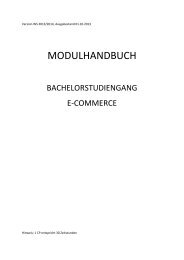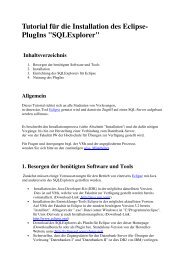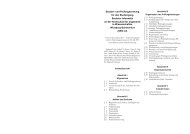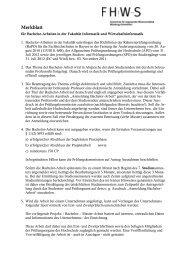FHWS Science Journal - Fakultät Informatik und Wirtschaftsinformatik
FHWS Science Journal - Fakultät Informatik und Wirtschaftsinformatik
FHWS Science Journal - Fakultät Informatik und Wirtschaftsinformatik
You also want an ePaper? Increase the reach of your titles
YUMPU automatically turns print PDFs into web optimized ePapers that Google loves.
Tobias Gegner<br />
2 INTRODUCING FLOW-DESIGN AND EVENT-BASED COMPONENTS<br />
The concept of Event-Based Components (EBC) was mainly introduced by Ralf Westphal, who<br />
started to post articles in his German and English speaking blogs [Westphal, 2010b, Westphal,<br />
2010d] in the year 2010. He also wrote articles about EBC in professional journals which will also<br />
be referenced in this paper. EBC is a new conceptual way to handle data communication between<br />
individual software components. It represents the code implementation of Flow-Design (FD),<br />
which is a different approach in designing software architectures. As the name Flow-Design<br />
already suggest it’s about flows. More concrete, FD describes function units and data that flows<br />
among them to fulfill business logic. Ralf Westphal evolved FD and the Flow-Orientation on the<br />
basis of Flow-Based Programming and Event-Based Programming concepts which are discussed<br />
in computer science for quite a few years [Morrison, 2010, Faison, 2006]. His work was also<br />
influenced by Business Process Modeling [Fre<strong>und</strong> and Rücker, 2012] and the Event-Driven<br />
Architecture [Bruns, Ralf and Dunkel, Jürgen, 2010]. Enriched with own thoughts he brought up a<br />
new approach of designing software: Flow-Design.<br />
In this paper the terms component and flow will play a major role. Therefore based on Ralf<br />
Westphals usage of the terms flow and component, these two terms will be defined as follows:<br />
Definition 1 (component). A component is a modular part of a software. It encapsulates a set of<br />
related functions or a single functionality, optionally its data. Further it is replaceable within its<br />
environment. Interfaces describe required and provided services. Within this paper the terms<br />
component and function unit are used synonymously.<br />
Definition 2 (flow). A flow represents communication among components of a software. It<br />
describes handing over control of data processing between components as well as hereby<br />
exchanged data. As an intellectual concept flows are depicted in diagrams.<br />
2.1 Running Example<br />
To make the difference of the FD approach clearer a sample application is examined. A<br />
command line tool has to be developed, that reformats text from a given file. It reads text from a<br />
file, rearranges the line breaks to a given line length and writes the resulting text into a new file.<br />
To start the application from command line, three parameters have to be provided by the user.<br />
First parameter names the file that contains the text. Second parameter defines the maximum line<br />
length to which the text is reformatted. Third parameter names the target file into which the result<br />
hast to be written. The application must not change nor apply hyphenation in its first version, this<br />
is left to future versions. The application has to guarantee, that the maximum line length is not<br />
exceeded nor that fewer words than possible are arranged in one line. Punctuations have to be<br />
considered as part of the preceding word and therefore must not be changed in any way<br />
[Westphal, 2011d].<br />
2.2 Flow-Design<br />
Designing software with the object-oriented analysis and design (OOAD) approach<br />
concentrates on building units of data with associated operations. That way the problem is<br />
60 <strong>FHWS</strong> <strong>Science</strong> <strong>Journal</strong>, Vol. 1, No. 1, 2013








